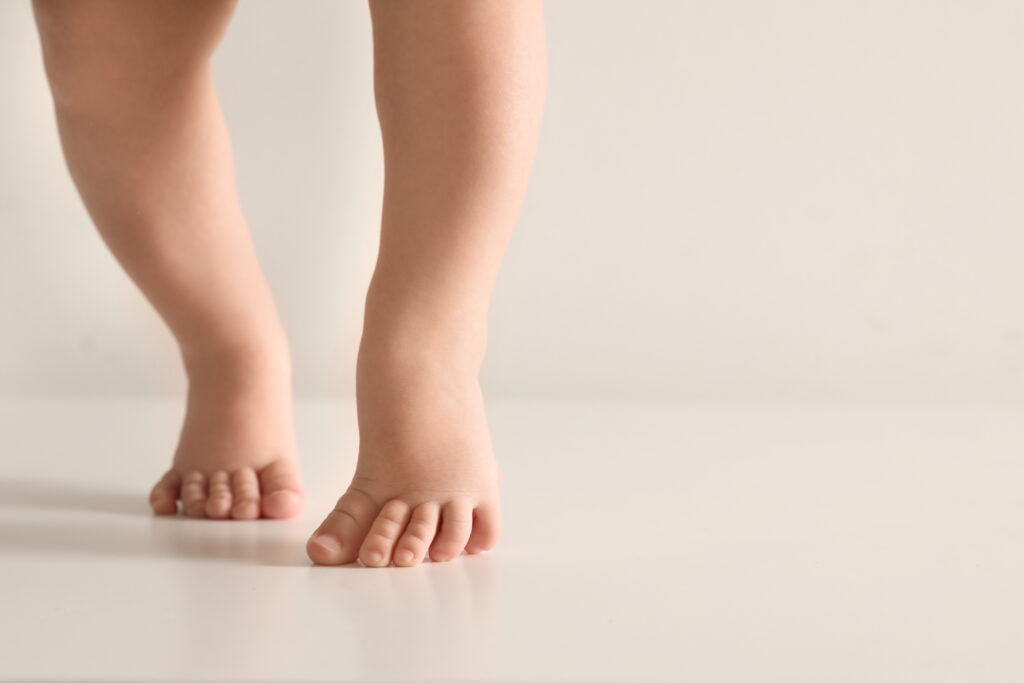As children grow, they may exhibit patterns of movement that will self-correct as they develop. Toe walking may be one of these movement patterns, and most of the time it is nothing to worry about. However, if left unattended, toe walking can prevent a normal gait or signal a more serious condition.
What Is Toe Walking?
Toe walking describes when children walk on the balls of their feet, with their heels raised off the ground. Generally speaking, toe walking is normal in children as they learn to walk. This is very common in young children as they develop coordination and balance, and in most cases self-correct around age two. It’s also normal for children to continue toe walking after this age out of habit, and is generally not cause for concern if there are no other signs of disordered physical development.
What Causes Toe Walking?
If toe walking continues beyond the age of two with no sign of improvement and/or evidence of other growth issues, it’s best to consult with an orthopedist about a possible underlying problem. Sometimes it is due to a short Achilles tendon, which prevents the heel from touching the ground. However, there are a variety of neurological or physical disorders that are causes of toe walking, such as:
- Cerebral Palsy and Toe Walking – Injury to or lack of development in the part of the brain responsible for muscle function leads to issues with muscle movement, as well as strength, tone, and posture. The muscles and tendons in a child’s calves and ankles may not be receiving the proper signal from the brain and therefore, won’t function properly.
- Muscular Dystrophy and Toe Walking – This genetic disease causes muscle fibers to become progressively weaker over time, inhibiting the strength needed for normal muscle movement. A diagnosis of muscular dystrophy is more common when a child begins to toe walk later in childhood due to the progression of muscle weakness.
- Autism and Toe Walking – Autism Spectrum Disorder presents differently in each individual, with toe walking being a possible physical symptom.
Treatments for Toe Walking
Treatments for toe walking vary depending on a child’s age and the severity of their case. If a child is under five years old and still able to connect their heels with the ground, or close to it, treatment will most likely involve specific stretches, physical therapy, and stretching of the Achilles tendon (for kids whose muscles are tight), braces or splints. The pediatric orthopedist may recommend casting that is changed periodically to assist tendons and muscles to stretch and grow properly.
Another non-surgical treatment for toe walking is wearing high-top sneakers; this can make it difficult to go up on their toes, which encourages the heel to touch the ground when walking.
Surgery for Toe Walking
Although many cases of toe walking can be remedied with non-surgical methods, there are cases where surgery for toe walking is necessary to restore range of motion. In children over the age of five, it is likely that their calf muscles and Achilles tendons are so tight that it is physically impossible to be flat-footed. In this case, a doctor will surgically lengthen the tendon, making it possible for the heel to meet the ground, and expanding the range of motion. For many patients, this surgery and subsequent usage of casts or splints will at least partially restore normal movement.
If your child’s toe walking is worrisome, reach out to a doctor as soon as possible. Your pediatric orthopedist will thoroughly analyze your child’s gait and musculature and may recommend EMG (electromyography) to pinpoint if there are any neurological conditions present. While visiting an orthopedist for a consultation, you can expect them to assess if there is any contracture or excess tightness in arm or leg muscles and determine their strength, check reflexes, and test how your child perceives sensation or feeling in their arms and legs.
If you are concerned about your child’s toe walking, don’t hesitate to contact TPOC at (973) 538-7700 and have your child seen by one of our pediatric orthopedists to determine the best course of action.



